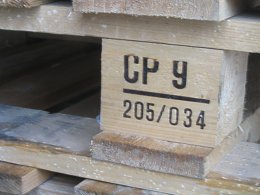
Chemical Pallets (CP Pallets) แพลเลทสำหรับเคมีภัณฑ์
Chemical pallets come in nine different sizes and were originally developed for use by the European Chemical and Plastics Industries to harmonize industry standards. Today chemical pallets are used in many industries and can serve as a good substitute for euro pallets because they have an exchange value in Europe at their end of life the supply chain.
แพลเลทเคมีคัลมีทั้งหมด9แบบซึ่งถูกออกแบบโดย European Chemical and Plastics Industriesเพื่อให้เป็นมาตรฐานสำหรับใช้ในกลุ่มอุตสาหกรรมเคมี ในปัจจุบันแพลเลทชนิดนี้ได้ถูกนำไปใช้ในอุตสาหกรรมประเภทอื่นด้วยโดยเฉพาะ อย่างยิ่งการนำไปใช้แทนแพลเลทEuroเนื่องจากแพลเลทชนิดนี้มีมูลค่าในการนำไปใช้ ร่วมกับระบบ Supply Chainได้นั่นเอง
Chemical pallets, known by their abbreviations as CP-Pallets are designated CP-1, CP-2, etc. We offer both used chemical pallets and new chemical pallets.
แพลเลทเคมีคัลหรือที่เรียกกันสั้นๆว่า CP Pallets มีทั้งหมด9แบบ สำหรับการใช้งานที่แตกต่างกันตามลักษณะการใช้งานของผู้ใช้
Please click here to view specifications and drawings of each CP type.
ต้องการดูSpecificationsของCP Pallet คลิกที่นี่
American chemical companies usually move their products in four primary types of packaging: drums -- both steel and other, supersacks, boxes, and bags. The pallet they choose is usually a fuction of the type of initial packaging they use, i.e. a "drum pallet" is usually between 44" x 44" and 48" x 48" and fully reversible because four drums will nicely fit on that footprint. CP pallets also generally correspond to a certain type of packaging and a certain type of handling such as racked vs. floor stacked, and single stacked vs. multiple loaded units stacked atop each other. Below are some generalities about each of the CP sizes.
CP-3 and CP-9:
Primarily used for drums and supersacks. CP-3 is the lighter-duty, non-perimeter bottom good for floor stacking, one or two units high. CP-9 is the heavier-duty, perimeter bottom good for floor stacking multiple loaded units high and for racking. The perimeter bottom prevents damage to the lower units by more evenly distributing the load.
ใช้มากในสินค้าที่ บรรจุในDrumsและถุงขนาดใหญ่โดย CP-3 จะใช้ในงานที่ น้ำหนักไม่มากหรือวางซ้อนกันไม่มาก ส่วน CP-9 นั้นแข็งแรงกว่าเนื่องจากมีไม้ที่ฐานล่างของแพลเลทรอบตัวแพลเลททำให้ สามารถรองรับน้ำหนักได้มากกว่า และไม่ทำให้สินค้าที่วางด้านล่างเสียหายอีกด้วย
CP-1 and CP-6:
These pallets are primarily used with sacks and boxes. As with the CP-3 and the CP-9, the primary difference is the perimeter bottom. The CP-1 is used with lighter loads. The CP-6 is more appropriate for floor stacking multiple loaded units and for racking. The perimeter bottom prevents damage to the lower units by more evenly distributing the load.
ใช้ กับสินค้าที่บรรจุในกล่องหรือถุงโดย CP-1 จะใช้ในงานปกติ ส่วน CP-6 จะใช้งานที่หนักกว่าเนื่องจากมีไม้ที่ฐานล่างของแพลเลทรอบตัวแพลเลททำ ให้สามารถรองรับน้ำหนักได้มากกว่า และไม่ทำให้สินค้าที่วางด้านล่างเสียหายอีกด้วย
CP-8:
This pallet is used solely for supersacks. It is dedicated to particular material handling equipment that allows a supersack to be placed on the pallet upside down, with the nozzle extended from which the material from the supersack can be poured.
แพลเลทชนิดนี้ใช้สำหรับถุงขนาดใหญ่ (Super Sacksหรือ Jumbo Bags) ที่มีช่องต่อจากปากถุงสำหรับใช้ในการเทของที่อยู่ในถุงออกมาใช้
CP-2:
This pallet type was designed to be a EUR Pallet replacement. This pallet is sometimes used in North America in place of a EUR pallet.
แพลเลทชนิดนี้มีขนาดเดียวกับEuro Palletsและสามารถใช้งานทดแทนกันได้ ในสหรัฐอเมริกาก็นิยมใช้แพลเลทชนิดนี้แทนแพลเลทยูโร